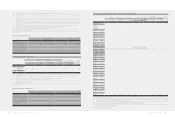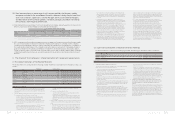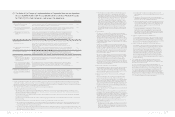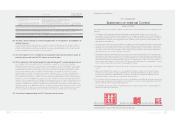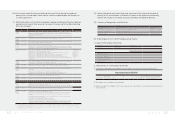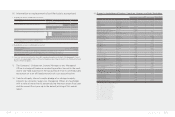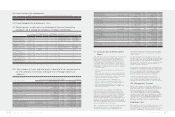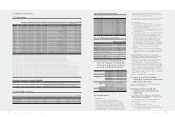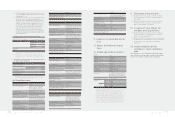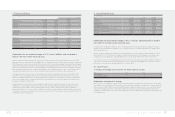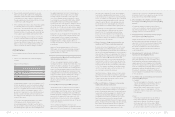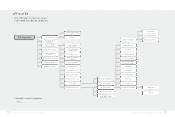HTC 2010 Annual Report Download - page 36
Download and view the complete annual report
Please find page 36 of the 2010 HTC annual report below. You can navigate through the pages in the report by either clicking on the pages listed below, or by using the keyword search tool below to find specific information within the annual report.
70 2 0 1 0 H T C A N N U A L R E P O R T 71
Corporate Governance
behind our eco-designs extends from their end-of-the-
pipeline treatment directly back to the initial design
stages; one consideration is the reduction in the use
of environmentally harmful substances such as lead,
cadmium, hexavalent chromium, and mercury. Another
requirement is increasing recycling and the ratio of
reusable components in products in order to reduce
negative environmental impacts. A variety of green
products have therefore been developed using design
concepts based on low toxicity, energy eciency, and
recyclability. These environmentally friendly products
not only meet customer needs but also conform with
international environmental regulations and help
enhance HTC's green competitiveness and its vision of
sustainable corporate development.
> Low toxicity design
In response to trends in international environmental
regulation and related concerns of our international
customers, HTC was already placing controls on
harmful substances in year 2000. By 2005, it had
produced the world's first PDA phone that met
standards of the EU's RoHS Directive (Restriction on
the Use of Certain Hazardous Substances in Electrical
and Electronic Equipment Directive). Since then, HTC
has required that all parts, modules, and materials
delivered to its plants conform with its substances
control checklist. Its control of restricted substances
goes beyond the six controlled substances listed in
the RoHS Directive, and includes other substances
such as formaldehyde, ozone-depleting substances,
and chlorinated paran, which, pursuant to
international environmental laws and regulations or
requirements of our international customers, are also
deemed controlled substances.
In hazardous substance management, HTC obtained
QC-080000 certification from the IECQ (International
Electrotechnical Commission Quality Assessment
System) in 2007. In 2010, it completed the second-
stage recertification audit to ensure that its hazardous
substance management system continues to operate
eectively on an ongoing basis.
> Energy-ecient designs
From the point of view of the overall life cycle of an
electronic communications product, the period of
use by the consumer is the most energy-intensive.
Most production of greenhouse gases in connection
with those products occurs during this stage. For
that reason, HTC puts a lot of emphasis on energy
eciency during the research and development
process. As part of our concern for energy eciency,
all HTC product power supplies must conform to the
international energy use standards below:
• The US EPA Energy Star program
• California Energy Commission standards
• The EU Code of Conduct
• The EU EuP Directive
In addition, our R&D team has developed outstanding
power management systems. Based on consumer
habits, handsets automatically switch to energy-
saving mode that reduces energy use and extends
battery life. Some models also include light sensors
that trigger an automatic LCD backlighting function,
which not only creates more readable displays but
also saves energy.
> Design for recyclability
HTC makes design-for-recyclability assessments
and other simulations part of its initial research
and development. It disassembles products and
performs material simulations to estimate materials
compositions and recycling rates. Labeling of
materials, simplified component design, and design
for ease of disassembly are strategies used to provide
feedback on designs to the R&D team. Current HTC
products are designed to meet both current and
future recycling standards.
> Green packaging
In addition to visual appeal and packaging strength,
HTC's green packaging concepts extend to
developing materials that satisfy the environmental
design concepts of low toxicity, low volume, and
recyclability.
• Low-toxicity design
- Packaging materials meet the standards of the EU
directive on packaging materials. Levels of lead,
cadmium, mercury, and hexavalent chromium are
all below legal limits.
- Packaging materials use no PVCs.
- Packaging materials contain no ODS (ozone
depleting substances) restricted by the Montreal
Protocol.
- Printing inks are low-volatility or environmental
vegetable-based inks such as soy ink.
• Low-volume design
- Expanded polystyrene foam (EPS) beads are not
used for packing.
- Volume per unit of stacking space is maximized to
reduce the amounts of packing materials required
during shipping.
- Improved shock-absorbing packaging reduces
the need for shock-absorbing packing materials
during shipping.
• Design for recyclability
- Our corrugated board for mobile phone
packaging is manufactured with more than 90%
recycled paper.
- If the use of virgin materials is dicult to
avoid because of visual design considerations,
packaging materials with FSC (Forest
Stewardship Council), PEFC (Programme for the
Endorsement of Forest Certification schemes), or
SFI (Sustainable Forestry Initiative) certification
are used.
Recycling and reuse of waste materials
HTC's primary product lines are handheld computers
and smart phones. During their manufacture, only
soldering generates exhaust emission. No wastewater is
produced, with the exception of domestic wastewater
from employees. HTC makes pollution control a high
priority, devoting extensive funding to pollution control
facilities and the deployment of dedicated personnel to
reduce environmental impact. The Company provides
personnel with external training to obtain relevant
certification, allowing them to assume full responsibility
for the management of pollution control facilities.
Through training and auditing, normal operation of all
pollution controls is maintained through appropriate
management designed to steadily diminish our
environmental impact. HTC anticipates continued
reduction in environment impact and achievement of
the goal of completely "clean production."
> HTC's strategy for waste reduction begins with HTC's
strategy for waste reduction begins with rigorous
sorting and waste reduction. Production of waste
is reduced from the beginning, while priority is
also given to reuse of materials in order to improve
recycling rates. The parts of plastic assembly panels
that can be recycled are reused, and the remaining
recyclable materials are outsourced to a recovery
enterprise approved by the Ministry of Economic
Aairs' Industrial Development Bureau for purification
and processing into industrial-grade materials for
further use. The resulting average annual recycling
rate is higher than 62 percent.
Other waste is dealt with by physical sorting to
increase reusability; and parts that cannot be
reused are incinerated. Only when landfill disposal
is unavoidable does it become the final method of
handling. HTC carries out regular online reporting in
accordance with laws and regulations with regard to
the status of production and temporary storage of
waste.
> One of HTC's environmental initiatives is to minimize
waste by recycling general domestic waste such as
aluminum foil, PET bottles, steel and aluminum cans,
and plastic containers. Used batteries, fluorescent
light tubes, and computer and electronics equipment
are also fully recycled.
> Employees are provided with environmentally friendly
tableware for use in the employee cafeteria. Eco-
friendly reusable cups are also provided for internal
personnel, guests, and people visiting on business in
order to reduce the use of paper cups.
> In observance of Earth Day, HTC promoted the use
of eco-friendly reusable cups in cooperation with its
on-site 7-11 and Starbucks by oering discounts to
employees who bring their own reusable cups when
they make purchases.
Promoting green buildings
HTC has already moved to introduce green building
techniques in its new headquarters, which are expected
to meet the US LEED (Leadership in Energy and
Environmental Design) green building standards. These
standards will be observed for all new buildings and
plants in the future and will allow HTC to provide even
more environmental, energy-saving, pleasant, and
healthy working environments.
Charitable activities
In addition to environmental protection, health and
safety, energy management, and providing a safe and
healthy working environment for its workers, HTC
continues to engage in other public service activities
such as caring for the victims of the February 28 floods
in Taiwan, making donations of blood, employing
people with disabilities, and taking part in community
environmental cleanups. The HTC Foundation also
promoted character-building educational activities for
children and young people.
HTC and World Vision Taiwan teamed up to provide
temporary housing units in Jinfeng Township, Taitung
County. They were the first completed temporary
housing units to be occupied by victims of the February
28 floods, and won the praise of President Ma Yingjiou
on an inspection tour. President Ma oered personal
encouragement when HTC organized the first echelon
of volunteer workers to serve in the disaster area, which
resulted in a very special kind of Mid-Autumn Festival
experience for all of the participating employees. In
addition, to help children living in the aected area
leave the experience behind, HTC employees organized
on their own a caring mission to the Jialan tribe of
Taitung. Through their "surprise shoebox" campaign,
they donated gift boxes that conveyed their well wishes
in a way that the children in the disaster will remember
all their lives.
In recent years, HTC has been involved with promoting
character-building education for children and young
people, working together with city and community
eorts to create a culture of character and showing
concern for disadvantaged groups by providing extra
educational opportunities for their children. In addition
to providing programs to encourage continuing study,
HTC also works tirelessly with others to help promote
a culture of values which will foster individuals who
are upright, honest, caring, positive and concerned
about natural resources. HTC is continuing a three-
year project it began in March 2008 when it signed
a "character white paper" with the Taoyuan County
Government to create "100 character-building schools,"
promoting character education in all areas among
educational administrators, schools, communities, and
families. HTC's character village project is underway in
Hualien County's Yu Li Township and Taoyuan County's
Long Tan Township, where it has signed related
memorandums of understanding to promote a culture
of character education through character training and
class work. HTC, in cooperation with the Hualien County
Government, has established a Character and English
Institute in Hualien's Meilun district, which is already
operating. The Institute's first location was set up in
idle facilities at the Ci Zhih School in Hualien. Thorough
renovation by HTC made the facilities look new again;
and it began providing free classes so students could
study character and English there in an enjoyable
and pressure-free environment. A new Character and
English Institute has been set up in Yunlin and began
operating in September 2010 in the same mode as the
Hualien Institute, providing educational opportunities
to children of disadvantaged groups or those living in
remote areas. A third Character and English Institute is
planned for Chiayi, and is scheduled to begin operating
in September 2011.


